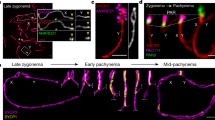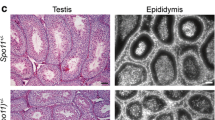Abstract
The establishment of the complete karyotype of human pachytene spermatocytes reveals differences in stretching of chromosomes between meiosis and mitosis. Bivalents or specific regions of bivalents which exhibit many R-bands are particularly elongated. In mitotic chromosomes, the DNA contained in such bands is known to be early replicating. The study of variations in the total length and the centromeric index of bivalent 1 suggests that differential elongation of pachytene bivalents is a premeiotic event, taking place during the last DNA replication.
Similar content being viewed by others
References
Chandley AC (1986) A model for effective pairing and recombination at meiosis based on early replicating sites (R-bands) along chromosomes. Hum Genet 72:50–57
Chandley AC, McBeath S (1986) DNAase I hypersensitivity characterizes the XY pairing region at meiosis in man. Chromosomes Today. 9:197–207
Dutrillaux B, Laurent C, Couturier J, Lejeune J (1973) Coloration par l'acridine orange de chromosomes prélablement traités par le 5-bromodeoxyuridine (BUDR). CR Seances Acad Sci [III] 276:3179–3181
Dutrillaux B, Couturier J, Richer CL, Viegas-Pequignot E (1976) Sequence of DNA replication in 277 Rand Q-bands of human chromosomes using a BrdU treatment. Chromosoma 58:51–61
Goldman MA, Holmquist GP, Gray MC, Caston LA, Nag A (1984) Replication timing of genes and middle repetitive sequences. Science 224:686–692
Guichaoua MR, Delafontaine D, Taurelle R, Taillemite JL, Morazzani MR, Luciani JM (1986) Loop formation and synaptic adjustment in a human male heterozygous for two pericentric inversions. Chromosoma 93:313–320
Holm PB, Rasmussen SW (1977) Human meiosis. I. The human pachytene karyotype analyzed by three-dimensional reconstruction of the synaptonemal complex. Carlsberg Res Commun 42:283–323
ISCN (1978) An international system for human cytogenetic nomenclature. Cytogenet Cell Genet 21:313–409
Jagiello GM, Fang JS (1982) Complete autosomal chromomere maps of human early and mid/late pachytene spermatocytes. Am J Hum Genet 34:112–114
Jhanwar SC, Burns JP, Alonso ML, Hew W, Chaganti RSK (1982) Mid-pachytene chromomere maps of human autosomes. Cytogenet Cell Genet 33:240–248
Jhanwar SC, Jensen JI, Kaelbling M, Chaganti RSK, Klinger HP (1986) In situ localization of human fibronectin (FN) genes to chromosome regions 2p14--p16, 2q34--q36, and 11q12.1--q13.5 in germ line cells, but to chromosome 2 sites only in somatic cells. Cytogenet Cell Genet 41:47–53
Jorgensen AL, Bak AL (1981) The length of silver-stained human autosomal pachytene chromosomes. Hum Genet 59:108–111
Kerem BS, Goitein R, Diamond G, Cedar H, Marcus M (1984) Mapping of DNAase I sensitive regions on mitotic chromosomes. Cell 38:493–499
Latt SA (1973) Microfluorometric detection of deoxyribonucleic acid replication in human metaphase chromosomes. Proc Natl Acad Sci USA 70:3395–3399
Lavappa KS (1983) Heterochromatin in X and Y chromosomes of the Armenian hamster. XVth Int Cong Genet New Delhi, p 155 (Abstract)
Luciani JM, Morazzani MR, Stahl A (1975) Identification of pachytene bivalents in human male meiosis using G-banding technique. Chromosoma 52:275–282
Luciani JM, Guichaoua MR, Morazzani MR (1984) Complete pachytene chromomere karyotypes of human spermatocyte bivalents. Hum Genet 66:267–271
Murer-Orlando M, Richer CL (1983) Heterochromatin heterogeneity in Chinese hamster sex bivalents. Cytogenet Cell Genet 35:195–199
Oud JL, Reutlinger AHH (1981) Chromosome behaviour during early meiotic prophase of mouse primary spermatocytes. Chromosoma 83:395–407
Oud JL, de Jong JH, de Rooij DG (1979) A sequential analysis of meiosis in the male mouse using a restricted spermatocyte population obtained by a hydroxyurea/triaziquone treatment. Chromosoma 71:237–248
Raman R, Nanda I (1986) Mammalian sex chromosomes. I. Cytological changes in the chiasmatic sex chromosomes of the male musk shrew. Suncus murinus. Chromosoma 93:367–374
Solari AJ (1980) Synaptonemal complexes and associated structures in microspread human spermatocytes. Chromosoma 81:315–337
Author information
Authors and Affiliations
Rights and permissions
About this article
Cite this article
Luciani, J.M., Guichaoua, M.R., Cau, P. et al. Differential elongation of autosomal pachytene bivalents related to their DNA content in human spermatocytes. Chromosoma 97, 19–25 (1988). https://doi.org/10.1007/BF00331791
Received:
Issue Date:
DOI: https://doi.org/10.1007/BF00331791




